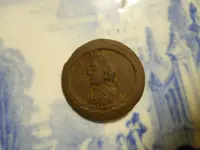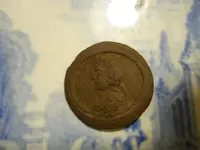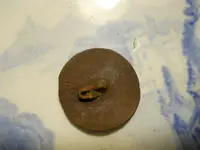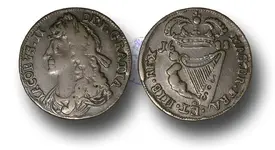This portrait bust image button is indeed quite the mystery, and one that undoubtedly has significance. The long flowing curly hair, is a style quite indicative of the 17th and 18th centuries A study of the portraits of prominent figures of the era, shows the style throughout Europe, in the circles of wealth and power. By the beginning of the 19th century though, this hair style had all but vanished. The particular style of button, being flat one-piece brass, with an attached wire shank, is generally considered to be 1790's-1840's period. The time period could maybe be stretched just a few years either way, yet flat one-piece brass buttons with attached wire shanks are almost never encountered in context with American Revolutionary War sites or earlier. I will venture a couple of further thoughts, for a possible connection.
William Pitt, The Elder:
http://en.wikipedia.org/wiki/William_Pitt,_1st_Earl_of_Chatham
William Pitt, The Younger:
http://en.wikipedia.org/wiki/William_Pitt_the_Younger
Considering that William Pitt, The Younger, died in 1806, could possibly provide a logical connection to the "180?" date/numeral on the back of this button.
There are also known to be examples of buttons bearing the likeness of William Pitt, The Elder:
http://historical.ha.com/c/item.zx?saleNo=6035&lotNo=47001
http://www.worthpoint.com/worthopedia/early-1760-william-pitt-stamp-act-137485364
http://historical.ha.com/c/item.zx?saleNo=6032&lotNo=47109
An additional observation, is that there certainly appears to be something quite odd in the vicinity of the bridge of the nose for the fellow depicted on the button. It could be debated that this is merely a flaw in the design, possibly a stray bit of corrosion, or maybe an area of patina inconsistency. However, the more I study this, it seems to me the fellow has a "Colonial Clothespin" stuck on his nose!

Could this be a satirical image in reference to a dignitary having a position that something stinks? Maybe the Stamp Act?
CC Hunter










 Could this be a satirical image in reference to a dignitary having a position that something stinks? Maybe the Stamp Act?
Could this be a satirical image in reference to a dignitary having a position that something stinks? Maybe the Stamp Act?  ..........somebody was just saying that!!!!!Great eye Matt!!!
..........somebody was just saying that!!!!!Great eye Matt!!!![BenFranklin[2].webp](/data/attachments/585/585322-0121e4fe30c56cec97133b88105e3b37.jpg?hash=2r85U0pgoS)



